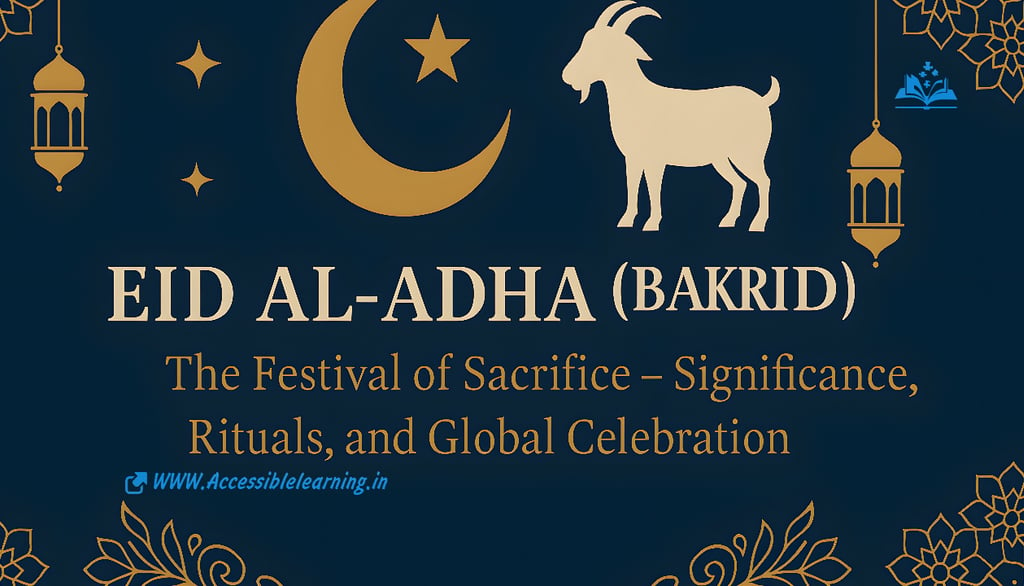
Eid al-Adha (Bakrid): The Festival of Sacrifice – Significance, Rituals, and Global Celebration
Discover the meaning, significance, rituals, and global traditions of Eid al-Adha (Bakrid), Islam’s Festival of Sacrifice. Learn how it’s celebrated, why it matters, and interesting facts that make this festival spiritually profound and culturally rich.
CULTURE/TRADITIONEVENT/SPECIALA LEARNINGCELEBRATION/FESTIVALS
Keshav Jha
6/1/20254 min read


Eid al-Adha, also known as Bakrid in the Indian subcontinent, is one of the two major Islamic festivals celebrated worldwide. Known as the "Festival of Sacrifice," it holds deep spiritual significance for Muslims and is marked by acts of devotion, charity, and unity. Observed during the 10th day of Dhu al-Hijjah (the last month of the Islamic lunar calendar), Eid al-Adha commemorates the unwavering faith of Prophet Ibrahim (Abraham) and his willingness to sacrifice his son as an act of obedience to God.
Origin & Religious Significance
At the heart of Eid al-Adha lies the story of Prophet Ibrahim’s sacrifice. As narrated in the Quran, Ibrahim had a divine vision commanding him to sacrifice his beloved son, Ismail. Submitting to God's will, he prepared for the sacrifice. However, God intervened at the last moment and replaced Ismail with a ram, symbolizing divine mercy and the importance of faith and obedience.
This act is not just a tale of devotion but a spiritual lesson on submission, trust, and sacrifice in the path of righteousness. Eid al-Adha coincides with the completion of Hajj, the annual pilgrimage to Mecca, further intensifying its spiritual depth.
When is Eid al-Adha celebrated?
Since the Islamic calendar is lunar, the dates for Eid al-Adha shift each year by about 10–11 days in the Gregorian calendar. The festival is observed on the 10th day of Dhu al-Hijjah and lasts for about three days in many countries.
In 2025, Eid al-Adha is expected to fall on the 6th or 7th of June, depending on moon sightings in different regions.
Major Rituals & Practices
Qurbani (Sacrificial Offering)
The most central ritual is the sacrifice of a permissible animal—usually a goat, sheep, cow, or camel. This act mirrors Ibrahim’s willingness to sacrifice his son and is performed after the Eid prayer.
The meat is divided into three parts:
One-third for the family
One-third for relatives and friends
One-third for the poor and needy
This distribution reflects Islam’s emphasis on community welfare and charity.
Eid Prayer (Salat al-Eid)
Held in large congregations at mosques or open fields, the Eid prayer is a collective act of worship that begins the day. It is usually followed by a sermon (khutbah) emphasizing the values of sacrifice, gratitude, and compassion.
Wearing New Clothes
Muslims dress in their best traditional attire—often newly purchased or gifted—for the occasion. This is a symbol of joy, self-respect, and reverence for the blessed day.
Charity & Helping the Needy
Aside from Qurbani, giving zakat and sadaqah (voluntary charity) is encouraged. Many Muslims use this occasion to sponsor meals, provide clothes, or support social causes.
Celebrations Across the World
While the essence of Eid al-Adha is universal, the cultural expressions vary:
In India and Pakistan, families often gather for a hearty feast of biryani, kebabs, and sweets like sheer khurma. Children receive “Eidi” (money or gifts) from elders.
In the Middle East, especially in countries like Saudi Arabia, the emphasis is on prayer, large-scale sacrifices, and communal dining.
In Western countries, Muslims often visit local slaughterhouses or contribute to overseas Qurbani programs. Interfaith Eid gatherings and open mosque days are common to promote unity and awareness.

🌙 Interesting Facts About Eid al-Adha (Bakrid)
Eid al-Adha Is Bigger Than Eid al-Fitr
While Eid al-Fitr is often celebrated with more visible enthusiasm, Eid al-Adha is actually considered the "Greater Eid" in Islamic tradition due to its deep connection with Hajj and the act of sacrifice.
It Coincides with the Hajj Pilgrimage
Eid al-Adha takes place during the Hajj pilgrimage, specifically after the Day of Arafah, which is considered the holiest day in Islam. Muslims who are on pilgrimage perform different rituals in Mecca, while others around the world celebrate Eid.
The Sacrifice Isn’t Mandatory for Everyone
Contrary to popular belief, Qurbani is only obligatory for Muslims who are financially able to afford it. Those not in a position to give are exempt without guilt, which emphasizes Islam’s compassion and fairness.
One Animal Can Be Shared
A single goat or sheep is for one person.
A cow or camel can be shared by up to seven people. This collective approach promotes unity and cost-sharing in communities.
The Meat Is Divided with Careful Precision
Islamic tradition mandates the equal distribution of meat—one-third each to the family, relatives/friends, and the poor. This structured sharing ensures food security and brings joy to underserved communities.
Online Qurbani Is Gaining Popularity
With the rise of technology, many Muslims are opting for digital Qurbani platforms. These services perform the sacrifice on behalf of users and distribute the meat in impoverished areas around the world—bringing global outreach to a local ritual.
Animals Must Be Treated Kindly
Islam has strict rules for humane treatment of animals. The sacrifice must be done swiftly and without causing unnecessary pain, and the animal must be healthy and free of defects—showing Islam’s emphasis on ethics.
Eid Is a Public Holiday in Over 50 Countries
Eid al-Adha is recognized as a national holiday in Muslim-majority countries and several others, including
Saudi Arabia
India
Pakistan
Indonesia
Nigeria
Egypt
Malaysia
South Africa
Even in Western countries, schools and workplaces often offer flexibility for Muslim employees and students.
“Eid Mubarak” Isn’t the Only Greeting
In various parts of the world, people greet each other with local variations:
“Eid Sa'id” (Happy Eid—Arabic)
“Bayramınız Kutlu Olsun.” (Turkish)
“Selamat Hari Raya Haji” (Malay)
“Eid al-Adha Mubarak” (South Asia)
It Fosters Interfaith Understanding
In multicultural societies, Eid al-Adha celebrations often include interfaith open houses, educational events, and invitations to non-Muslim friends, making it a bridge between communities and cultures.
Modern-Day Qurbani: Ethical & Digital Shifts
With urban lifestyles and growing awareness about animal rights and hygiene, many Muslims now:
Opt for certified online Qurbani services
Donate to international aid agencies that perform sacrifices in impoverished regions
Use the festival to advocate for sustainability and humane practices
This digital evolution of tradition reflects how faith adapts to modern needs without losing its core.
Why Eid al-Adha Matters in Today’s World
In a time of global challenges—conflict, inequality, and environmental stress—Eid al-Adha serves as a moral compass. It teaches:
Empathy for the less fortunate
Sacrificing personal comfort for communal well-being
Spiritual resilience and trust in divine wisdom
It is more than a ritual—it is a reminder to live selflessly, act justly, and uplift others.
Eid al-Adha (Bakrid) is not merely a festive occasion but a spiritual milestone—a day to reflect on sacrifice, share our blessings, and strengthen the human bond across borders and beliefs. In embracing the values of compassion, humility, and devotion, this sacred festival continues to inspire generations of Muslims to live a life of meaning, service, and love.
Subscribe To Our Newsletter
All © Copyright reserved by Accessible-Learning Hub
| Terms & Conditions
Knowledge is power. Learn with Us. 📚


